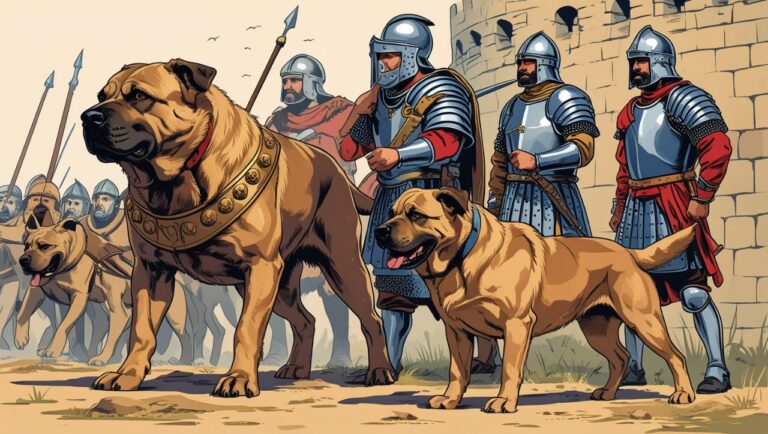Dogs in Disaster Response History

Introduction to Dogs in Disaster Response History
Throughout history, dogs have proven to be invaluable assets in disaster response efforts. Their keen sense of smell, agility, intelligence, and unwavering loyalty make them uniquely suited to assist in search, rescue, and recovery operations. From earthquake zones to bombed-out cities and collapsed buildings, dogs have consistently saved lives, detected survivors, and comforted victims during times of immense crisis. The history of dogs in disaster response is not just about the tasks they perform but the trust they inspire in their human counterparts. This article traces the evolution of canine involvement in disaster relief from early records to modern deployments across the globe.
Origins of Canine Search and Rescue Work
The use of dogs in disaster response dates back to ancient and medieval times. Historical accounts describe dogs locating people buried in avalanches and assisting in battlefield casualty recovery. However, formalized use began in the 18th and 19th centuries, most notably with the monks of the Great St. Bernard Hospice in the Swiss Alps who bred and trained St. Bernard dogs to locate travelers lost in snowstorms. These early avalanche rescue dogs, such as the legendary Barry, set the standard for search-and-rescue operations. Their success laid the groundwork for the institutionalized training of dogs for emergency response roles in civilian contexts.
World War Contributions and Urban Disaster Assistance
World Wars I and II brought a new dimension to canine disaster roles. Dogs were trained not only for battlefield tasks but also for civilian protection. In war-torn cities like London and Berlin, dogs helped locate victims buried under collapsed buildings caused by bombings. Their ability to navigate tight spaces and detect humans beneath rubble saved countless lives. Military dogs also assisted medics in locating wounded soldiers on the frontlines. These wartime applications demonstrated the versatility and reliability of dogs in responding to urban disasters, expanding their use into civilian emergency services post-war.
Post-War Developments in Search and Rescue Dog Training
After World War II, many countries formalized their approach to canine search and rescue training. Germany, Switzerland, and the United States led early efforts to develop standardized training protocols. Organizations such as the International Rescue Dog Organisation (IRO), founded in 1993, were created to promote cooperation and elevate training standards globally. Training centers focused on obedience, agility, scent tracking, and disaster simulation drills. Dogs were trained to identify human scent in various scenarios including rubble, forested terrain, and water. These advancements transformed dogs from informal assets to indispensable tools within structured disaster response teams.
Canine Heroes in Earthquake Response History
Earthquakes have historically been among the deadliest and most destructive disasters. Dogs have played critical roles in nearly every major earthquake since the 1960s. During the 1985 Mexico City earthquake, search-and-rescue dogs helped locate dozens of survivors in the rubble of collapsed apartment buildings. In the aftermath of the 1999 İzmit earthquake in Turkey, over 20 specially trained dogs from countries like the U.S., Germany, and Switzerland were deployed to aid local responders. In both cases, canine teams accelerated search operations and directly contributed to successful rescues, especially during the critical 72-hour window for saving lives after a quake.
Dogs at Ground Zero: 9/11 and National Tragedy Response
The September 11, 2001 terrorist attacks marked a defining moment in the history of disaster response dogs. Over 300 search-and-rescue dogs were deployed to Ground Zero in New York City, including famous dogs like Bretagne, a golden retriever who worked tirelessly alongside firefighters and first responders. These dogs searched tirelessly through toxic debris, often for weeks, in hopes of locating survivors. Their presence provided emotional support to rescue workers, offering a symbol of hope and resilience. Many of these dogs later developed health issues related to prolonged exposure, sparking discussions about canine health protections during disasters.
Disaster Dogs in the Aftermath of Hurricane Katrina
In 2005, Hurricane Katrina devastated New Orleans and the Gulf Coast, leading to one of the largest animal-assisted disaster relief efforts in U.S. history. Canine teams from federal and volunteer organizations assisted in search missions, locating survivors trapped in homes, attics, and debris fields. Dogs also helped cadaver recovery teams during later stages of the response. The scope of Katrina required logistical coordination among local, state, and federal agencies. This disaster highlighted the importance of inter-agency cooperation and the role of dogs in both rescue and recovery phases. Katrina also catalyzed improvements in disaster preparedness for animal response units.
The Role of FEMA Task Force Canine Units
The Federal Emergency Management Agency (FEMA) plays a central role in coordinating disaster response in the United States. Its Urban Search and Rescue (USAR) Task Forces include certified canine teams trained in live-find and human remains detection. These FEMA-certified dogs undergo rigorous training and testing through organizations like the National Disaster Search Dog Foundation (NDSDF). They are trained to identify live scent and differentiate it from inanimate objects or deceased individuals. FEMA canine units are often first responders to domestic and international disasters and have been deployed to earthquakes, building collapses, and mass casualty events across the globe.
Training and Certification of Disaster Response Dogs
Training a disaster response dog can take 18 to 24 months. The process begins with selection—dogs must have strong drive, high energy, and a stable temperament. Breeds commonly used include Belgian Malinois, German Shepherds, Labrador Retrievers, and Border Collies. Training includes obedience, agility, scent discrimination, directional control, and scenario simulations involving rubble piles and confined spaces. Certification is typically issued by national organizations such as FEMA, IRO, or state-level search and rescue associations. Ongoing drills and annual recertification ensure readiness for real-world deployments. Only the most reliable dogs are allowed to serve in life-or-death search missions.
Dogs in Avalanche and Mountain Rescues
In alpine environments, dogs are among the fastest and most effective tools for locating buried victims after an avalanche. These dogs can locate people under meters of snow in minutes, whereas it could take human rescuers hours. Countries like Switzerland, Austria, and Norway have specialized avalanche rescue units. The Swiss Alpine Rescue, for instance, uses dogs trained to detect scent through snow layers and navigate difficult terrain. Breeds like the St. Bernard, once iconic, have been largely replaced by lighter, more agile breeds such as German Shepherds and Belgian Malinois. These dogs operate with their handlers via helicopter insertions and ski patrol units.
also read this Dogs in Warfare and Service
Canine Contributions in Tsunami and Flood Disasters
Tsunamis and floods present unique challenges due to the presence of water, mud, and debris. Dogs trained for water rescues and cadaver detection have been deployed in disasters such as the 2004 Indian Ocean tsunami and the 2011 Japan tsunami. In these events, canine teams were critical in locating bodies for proper identification and closure for families. Specialized dogs capable of working in wet and unstable environments undergo additional conditioning to deal with scent dispersion in water and emotional stress from chaotic scenes. Their contributions in such disasters often go unrecognized despite their essential roles in forensic and recovery operations.
Psychological Support from Canine Teams
Beyond physical rescue, dogs provide immense emotional support during disasters. Their calm demeanor and nonjudgmental presence help soothe survivors, children, and emergency workers experiencing trauma. Following tragedies like the Sandy Hook Elementary shooting or the Joplin, Missouri tornado, therapy dogs were introduced to comfort survivors and aid in community healing. This cross-role of disaster response dogs—from physical search to psychological support—makes them uniquely adaptable assets in emergency management. The presence of trained comfort dogs has been shown to lower blood pressure, reduce anxiety, and promote psychological resilience during post-disaster recovery.
International Disaster Response and Canine Diplomacy
Disaster response often involves international cooperation. When earthquakes struck Haiti in 2010 and Nepal in 2015, canine units from countries like the United States, Mexico, Germany, and Canada were deployed through the United Nations’ INSARAG network. These dogs acted not just as rescuers but as symbols of global solidarity. Mexico’s famous rescue dog, Frida, became an international icon after the 2017 Puebla earthquake, credited with saving 12 lives during her career. Such stories elevate the profile of canine responders and strengthen the case for global standards in disaster dog deployment, certification, and handler support.
Challenges Faced by Disaster Response Dogs
Despite their heroism, disaster response dogs face numerous challenges. Exposure to toxic materials, sharp debris, extreme temperatures, and emotional fatigue can affect their physical and mental well-being. Many develop respiratory problems or joint issues after years of service. Psychological stress is also documented, particularly when dogs work for extended periods without locating survivors. This issue is addressed by integrating play and reward systems during training and real-world operations. Post-deployment veterinary care is now standard for most national units, and retirement programs ensure these dogs live comfortably after their service ends.
Retirement and Legacy of Canine Responders
Once their service ends, disaster response dogs are typically adopted by their handlers or placed with experienced families. Retirement often occurs between ages 8 and 10, though some continue longer in less demanding roles like training or demonstrations. Many organizations honor retiring dogs with medals, ceremonies, and lifetime medical care. Legacy projects, including statues and children’s books, help preserve their stories. The Search Dog Foundation maintains a Hall of Fame recognizing exceptional canine careers. These efforts ensure that the heroism of dogs in disaster response is remembered and celebrated.
Media and Public Perception of Disaster Dogs
Media portrayals of disaster response dogs have played a crucial role in public recognition. Documentaries, news specials, and viral social media posts during events like 9/11 and the Haiti earthquake helped humanize these animals and raise awareness of their contributions. Public admiration has led to increased funding for training programs, legislative support for working dog rights, and a cultural appreciation of dogs not just as pets but as working partners. Stories like that of Bretagne, the last surviving 9/11 search dog, drew national media attention and deepened public understanding of the bond between dog and handler.
Technological Enhancements in Modern Search Dogs
In recent years, disaster dogs have benefited from technological tools that enhance their performance. GPS collars track their movements in large search zones, while mounted cameras provide real-time visuals to commanders. New scent-detection algorithms are being developed to support canine findings with digital confirmation. Some dogs now wear lightweight protective gear, including booties, goggles, and cooling vests. While no technology can replicate a dog’s olfactory capabilities, these enhancements improve safety, communication, and overall mission success. The integration of bio-sensors to monitor dog stress levels is also under development, offering real-time health data during deployments.
Training the Next Generation of Disaster Dogs
Organizations like the National Disaster Search Dog Foundation and international partners are constantly refining training techniques. They focus on early identification of ideal puppy candidates, often rescuing dogs from shelters and turning them into elite responders. Training facilities simulate real disaster environments with rubble piles, confined spaces, and scent distractions. Handlers are trained alongside their dogs to ensure seamless communication. Programs now emphasize psychological conditioning, teamwork, and scenario diversity to prepare for a wide range of emergencies. The next generation of disaster dogs will be faster, more adaptive, and supported by a wealth of science-based training protocols.
Disaster Dogs in Developing Nations
While highly trained disaster dogs are more common in wealthy countries, initiatives are growing in developing nations. Nonprofits and international coalitions provide training, equipment, and funding to countries prone to natural disasters but lacking infrastructure. The use of dogs in the Philippines, Indonesia, and parts of Africa is increasing thanks to training partnerships. These programs not only save lives but also build local capacity, reduce reliance on foreign teams, and empower communities to manage their own emergency responses. As climate change increases disaster frequency, global access to trained dogs becomes more essential.
Ethical Considerations in Canine Disaster Deployment
The deployment of dogs in dangerous environments raises ethical questions. While dogs volunteer through their actions, they cannot consent to risk exposure. Handlers and agencies must weigh mission necessity against potential harm. Ethical best practices include limiting exposure time, rotating dogs, providing proper gear, and offering post-mission care. Animal welfare laws are increasingly incorporating working dog protections, ensuring they are treated as living team members rather than expendable tools. Ethical deployment affirms the value of these dogs not only in what they do but in how they are treated during and after service.
The Future of Dogs in Disaster Response
As disasters grow more frequent and complex, the role of dogs will continue to evolve. Emerging threats such as urban mega-quakes, industrial accidents, and climate-driven catastrophes will test the limits of existing search systems. Dogs will remain critical due to their unique ability to detect life in chaotic, inaccessible environments. Technology will support—but not replace—their natural abilities. Efforts are underway to improve data integration, expand international training standards, and increase funding for research into canine cognition and olfaction. The future will see more sophisticated canine units supported by real-time analytics, yet grounded in the timeless bond between dog and handler.
Conclusion
The history of dogs in disaster response is a story of bravery, loyalty, and profound human-animal cooperation. From the icy peaks of the Swiss Alps to the smoldering ruins of 9/11, these canines have proven themselves indispensable in our darkest hours. Their noses have found survivors, their presence has comforted the grieving, and their resilience has inspired entire communities. As we prepare for an increasingly uncertain world, the contributions of disaster response dogs remind us that sometimes, our greatest heroes walk on four legs.





